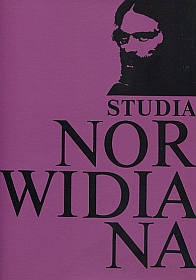„Świata-tego Książę”. Norwid's Faces of Satan
Abstract
Romanticism revived the earlier interest in the realm of evil and its dwellers. The literature of the period strikes us by the richness and multiplicity of its representations of Satan, comparable perhaps only to that found in the Middle Ages. Romantic writers viewed the figure of the fallen angel as a model of rebellious existence, one that suited the mood of the time. Therefore, European literature elevates the devil: he acquires the marks of tragic greatness.
Polish literature has few satanic heroes in the style of Byron. Foremost among the Promethean representations of Satan in Polish literature is Lucifer in Słowacki's play Samuel Zborowski. He pleads Zborowski's case before the court of God, defending even criminal acts if they were an expression of a free, creative spirit. Other Lucifer-like heroes are the altruistic devil in Mieczysław Romanowski's Anioł upadły and in Roman Zmorski's play Lesław, and the dark spirit in Kraszewski's Rapsod. Much more copiously represented is the type of Mephistophelean progeny; suffice it to mention the Black Hunter from Part I and the Spirits from Part III of Mickiewicz's Dziady, the Doctor from Kordian and Pamfil from the drama about Beniowski. Satan is a fallen angel, the most illustrious of God's creatures. He shows some, not always precisely defined, affinity with certain animals: his main embodiments are the dragon and the serpent. He remains forever the „enemy” of the sons of Adam, even if he can tempt them with prospects of an alliance and lead them astray with illusions. He will often misrepresent things. His followers worship him with rituals which parody religion and consist in fostering falsehood and giving praise to vanity and pride. His derisive separation from reality is expressed in his sardonic, malevolent laughter. Energetic and untiring, Satan is always ready to act. In the good world made by God, he „creates” suffering, death and time, a deformation of God's eternity.
Having analysed Norwid's texts which grapple with the problem of evil we have to say that the dictionary data given in the introduction fail to capture the richness of the representations of Satan in the work of the author of Zwolon. Even though his conventional appellations are fairly infrequent, Satan is a prominent presence in Norwid's writings, for the images of the Prince of Darkness, albeit few in number, have considerable significance for the interpretation of some of Norwid's important works. Various forms of evil are encountered in the Promethidion, Wigilia, and Rzecz o wolności słowa, in Norwid's uncommonly vivid youthful lyrical poems and the litany Do Najświętszej Panny Marii, in the poem Do Moskali-Słowian, in the epoch-making cycle of epigrams, and finally in the poet's journey through the inferno, the Vade-mecum collection.
Norwid linked Satan in a particular way with the multiply ambiguous concept of falsehood understood as the opposite of the supreme value, truth, which embraces all things that are good, holy, beautiful and important. Norwid stressed the devil's presence in civilisation and history, where he leaves his mark through his devoted human followers. Enslavement and authoritarianism, the instrumental treatment of individuals and nations all are the work of the evil spirit. Sometimes Satan loses his personal traits and turns into an amorphous evil element in man. His multiformity and changeability make him very difficult to see. But it is not true that metaphysical evil is absent from Norwid's world.
Copyright (c) 1999-2000 Studia Norwidiana

This work is licensed under a Creative Commons Attribution-NonCommercial-NoDerivatives 4.0 International License.





